Sots Press: Technique, Benefits & Common Mistakes
Author:
Unlock your full potential by engaging with our experts and community! Have questions about your fitness journey or looking for expert advice on weightlifting techniques? Don’t hesitate — leave a comment below and Oleksiy Torokhtiy will provide a personalized answer and insights to help you reach your goals.
Torokhtiy is reader-supported. Some links are affiliate links, and we may earn a commission at no extra cost to you. See our disclosure page for details.
The Sots Press is one of those underrated exercises that can truly transform your Olympic weightlifting game. It combines a squat and an overhead press, so it’s an actual powerhouse for building strength, mobility, and stability. Imagine pressing a barbell overhead while sitting in a deep squat – that’s the Sots Press.
It’s nor just about lifting heavy weights, although that’s a big part of it. But it’s also about doing it with control and precision. It doesn’t matter if you’re just starting out or if you have years of lifting experience, the Sots Press can help you improve your shoulder mobility, core stability, and overall athletic performance.
In this guide, we’ll go over everything you need to know about it, from what exactly it is and how to do it, to variations and mistakes to avoid.
If you want to improve your lifting game and boost your strength, the Sots Press is what you need.
What Is the Sots Press? – It’s a weightlifting exercise that involves pressing the barbell overhead while in the bottom position of the squat. It’s good for improving shoulder mobility, stability, and strength in general.
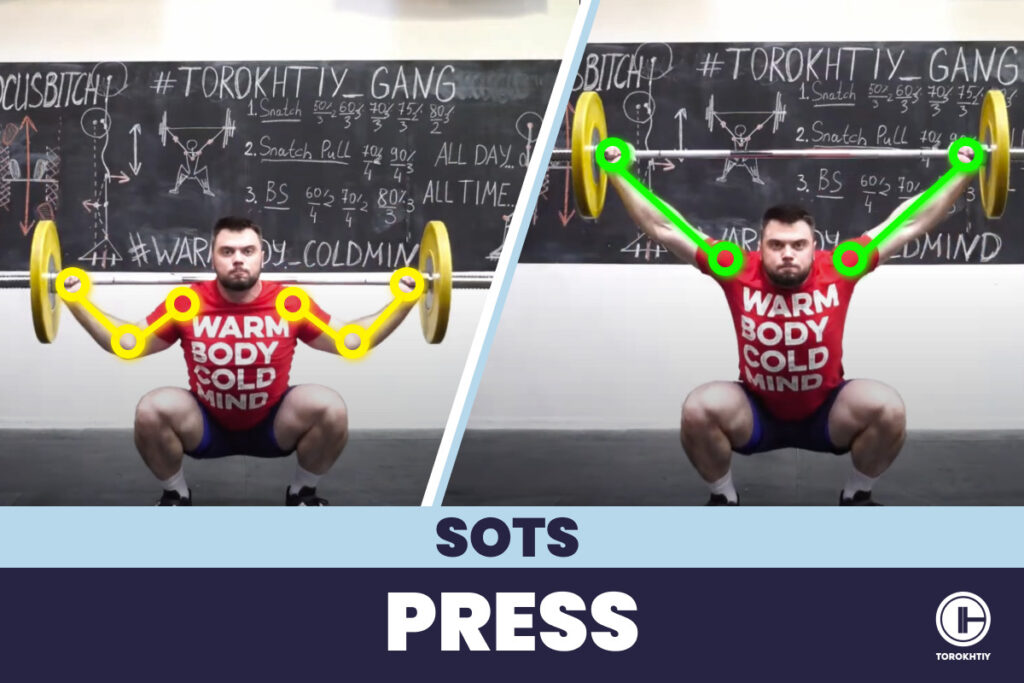
What is Sots Press?
The Sots Press is an exercise commonly used in Olympic weightlifting training programs to enhance upper body and shoulder mobility, stability, and strength. This exercise involves pressing a barbell overhead while in the bottom position of a squat, with the bar resting in back or front of the shoulders.
The creators of this exercise are the world champion Viktor Sots and his coach Pyotr Alaev. When they introduced it more than 35 years ago, they couldn’t have imagined it would become one of the most popular exercises in weightlifting.
The Sots Press, pressing from the back or front rack position in a deep squat, has various power and technical variations, all aimed at improving the squat position and strengthening and increasing shoulder joint mobility. This exercise is great for athletes of all levels and it’s included in training routines across all phases of preparation.
It’s a challenging exercise that needs a significant amount of upper body strength, as well as shoulder mobility, core stability, and leg strength. It can be used as part of a warm-up routine or as a supplemental exercise in an Olympic weightlifting program to improve overall athletic performance.
How To Perform Sots Press?
Now that you’ve got the general idea of what this exercise is, let’s see how to do it:
1. Start
Start by standing with your feet shoulder-width apart and hold the bar in the front rack (for clean) or in the back (for snatch) position. The grip width will be determined by the variation of the exercise you will choose – wide for snatch and narrower for clean.
2. Lower into a Deep Squat
Slowly lower yourself into a deep squat. Make sure to keep your chest up and your knees tracking over your toes. Your hips should be below parallel, and your back should stay straight throughout the movement.
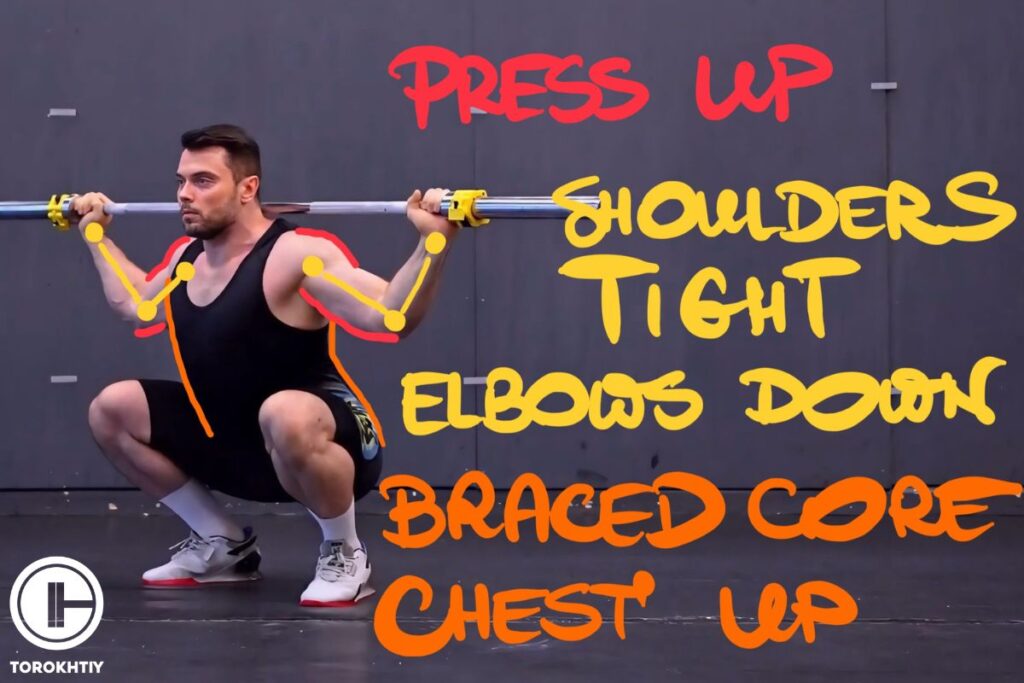
3. Pause
Once you’re in a deep squat, pause for a moment. Keep your torso upright and keep your core engaged. This position should feel stable and controlled before you move on to the press.
4. Press the Bar Overhead
From the bottom squat position, press the bar directly overhead. Extend your arms completely and keep your elbows locked out. Make sure to engage your shoulders and triceps while maintaining a stable core and balanced squat position.
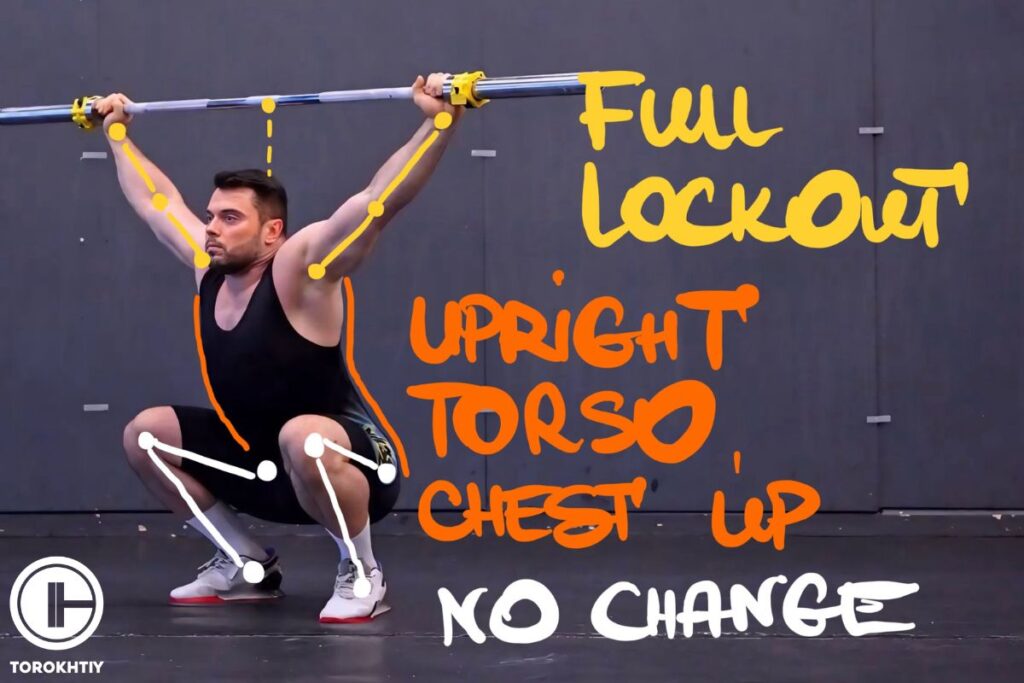
5. Control the Descent
After you’ve pressed the bar overhead, slowly lower it back to the starting position on your back or shoulders. Make sure to do everything in a controlled way; this will allow you to avoid jerking or losing your balance. Do as many reps as you need/want.
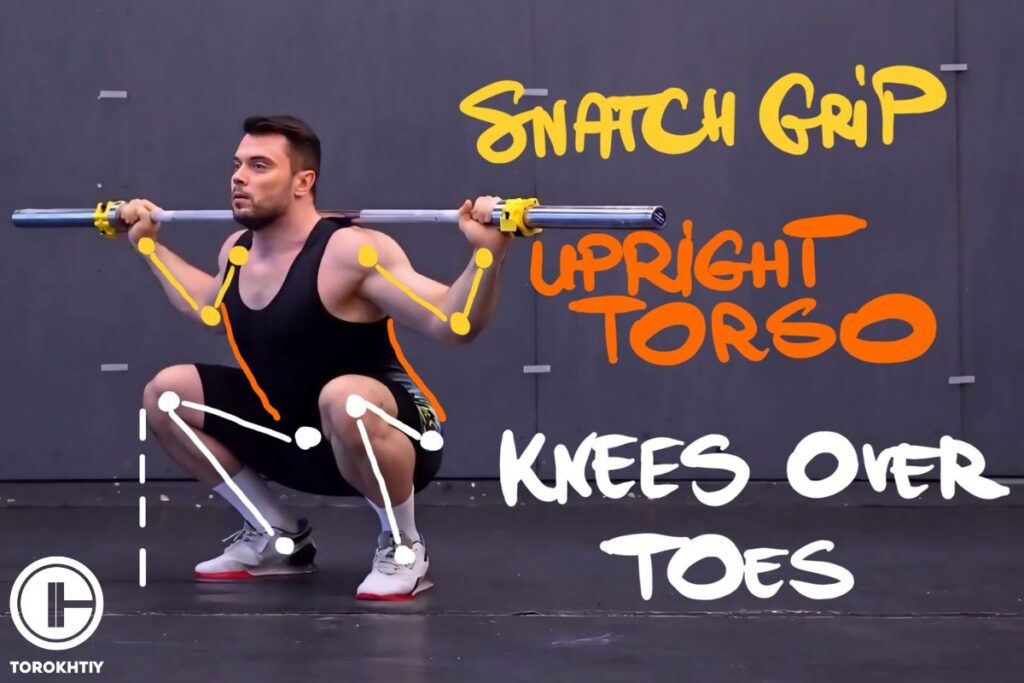
6. Stand Back Up
Once the bar is secure on your shoulders, stand up from the squat. You’ll need to keep your chest up and use your legs to drive yourself back to the position you started from.
7. Repeat
And that’s it! You’ve successfully completed the Sots Press exercise, now do it again anytime you need!
🔻Find Your Best Training: Take Our Quiz!
Are you ready to learn and grow? Take our simple quiz to discover the right training program for you. Let us help you succeed — click below to start the quiz!
How to Program Sots Press?
Beginner
- Sets: 3-4
- Reps: 5-8 reps per set
- Frequency: Do the sots press 1-2 times a week
- Tips for Progression: Focus on mobility and stability in the overhead position. Use light weights or an empty bar until you master the form, and then increase the weight in 5-pound increments
Intermediate
- Sets: 4-5
- Reps: 3-5 reps per set
- Frequency: Do the sots press 2-3 times a week
- Tips for Progression: Increase the weight you’re working with and incorporate pauses at the bottom of the squat to enhanced control. Work on shoulder and thoracic mobility to improve positioning and depth
Advanced
- Sets: 5-6 sets
- Reps: 2-4 reps per set
- Frequency: Do the sots press 2-3 times a week
Tips for Progression: Use heavier weights and focus on maximal control and precision. Add variations like tempo sots or pressing from different squat depths. Integrate the snatch sots press into complexes with other front squat assistance exercises
What muscles are working in Sots Press?
The Sots Press is a complex, demanding exercise, but it’s worth the effort because it engages a lot of your muscles at the same time and gives them an excellent workout. Here’s a breakdown of the muscles that get the most attention.
1. Shoulders (Deltoids)
Your deltoids are heavily engaged during the Sots Press, especially the anterior and medial parts. They’re responsible for lifting the barbell overhead and stabilizing it in the top position. If you strengthen your deltoids, it can improve your pressing strength and shoulder stability.
2. Triceps
Another group of muscles that are super involved – the triceps. They’re located at the back of the upper arm and they work to extend the elbow and push the bar up. Strong triceps are very important for a powerful, controlled press.
3. Core (Abs and Obliques)
You’ll have to keep your torso upright and stable during the deep squat and press, and that’s what your core is responsible for. The abs and obliques work together to keep your spine stable and prevent excessive leaning or arching. A strong core is crucial for overall stability and balance during the Sots Press.
4. Lower Back (Erector Spinae)
The erector spinae muscles in your lower back help you keep an upright posture during the squat and press phases. These muscles support the spine and they prevent rounding the back, which can mess up your form, and we all know that correct form is what keeps you safe.
5. Glutes
Although the Sots Press is primarily an upper body exercise, the deep squat you have to get into engages your glutes. The glutes help stabilize the hips and contribute to maintaining proper squat depth and form.
6. Quads
The quads are at the front of your thighs and they’re engaged during the squat portion. They work to extend the knees and provide stability in the deep squat position.
7. Hamstrings
The hamstrings are at the back of your thighs and, like the quads, they’re engaged during the squat part of the Sots Press. They work together with glutes and quads to maintain balance and control.
5 Sots Press Benefits for Olympic Weightlifters
The Sots Press is a complex exercise that can provide several benefits to Olympic weightlifters, including:
✅ Increased Flexibility
The Sots Press requires a high degree of flexibility in the shoulders, hips, and ankles. By performing this exercise regularly, weightlifters can improve their range of motion, which can help them perform better in other lifts.
✅ Improved Mobility
The Sots Press requires a significant amount of stability and mobility in the shoulders, upper back, and hips. This exercise can help improve overall mobility, making it easier for weightlifters to move more efficiently and effectively during their lifts.
Follow us!

Free!
Get a 2-week Weightlifting Program as a bonus for the subscription to kickstart your training plan!

Free!
✅ Enhanced Shoulder Strength
The Sots Press places a significant emphasis on the shoulders and upper back, specifically the rotator cuff muscles. These muscles are responsible for stabilizing the shoulder joint, which is essential for Olympic weightlifters who perform overhead lifts.
✅ Increased Core Strength
The Sots Press requires a significant amount of core strength to maintain proper form and stability throughout the movement. By incorporating this exercise into their training regimen, weightlifters can improve their core strength, which can help them perform better in other lifts.
✅ Improved Balance and Coordination
The Sots Press requires a high degree of balance and coordination, as weightlifters must maintain a stable position while performing the movement. By practicing this exercise regularly, weightlifters can improve their balance and coordination, which can help them perform better in other lifts and athletic activities.
6 Main Mistakes In Sots Press
The Sots Press is a challenging exercise that requires proper technique and form to perform correctly. Some common mistakes to avoid when performing the Snatch Sots Press include:
❌ Lack of Flexibility
The Sots Press requires a high degree of flexibility in the shoulders, hips, and ankles. If you don’t have sufficient flexibility in these areas, you may struggle to maintain proper form during the exercise. Try sots press exercise while sitting on a bench first and work your way from there.
❌ Poor Posture
Maintaining proper posture is essential when performing the Sots Press. If you hunch your shoulders or round your back, you may place unnecessary stress on your spine and increase the risk of injury. Try sots press exercise while sitting on a bench first and work your way from there.
❌ Incorrect Grip
Using an incorrect grip can make it difficult to maintain proper form during the Sots Press. Be sure to use a grip that allows you to keep your elbows high and maintain a stable position.
❌ Improper Foot Placement
Your feet play a crucial role in maintaining proper form during the Sots Press. Be sure to place your feet shoulder-width apart and maintain a stable base throughout the movement.
❌ Lack of Core Engagement
Your core muscles play an important role in maintaining proper form during the Sots Press. If you don’t engage your core muscles, you may struggle to maintain proper stability and balance during the exercise.
❌ Rushing the Movement
The Sots Press is a complex exercise that requires a slow and controlled movement. If you rush the movement, you may sacrifice proper form and increase the risk of injury.
Who Should Do the Sots Press?
The sots press is challenging, but it’s not just for advanced athletes; it can be good for anyone looking to improve their lifting technique and overall shoulder health. Here’s who should consider including the sots press into their training:
1. Olympic Lifters
The sots press improves stability and strength int he bottom position of the snatch and clean. It helps lifters improve their overhead positioning and balance.
2. Athletes Focused on Shoulder Mobility
If one of your training goals is to improve shoulder mobility and strength, the sots press is a great way to do that. It requires and builds flexibility in the shoulders, thoracic spine, and wrists.
3. Rehabilitation and Prehabilitation
For those recovering from shoulder injuries or want to prevent them, the sots press can be a beneficial exercise. It strengthens the smaller stabilizing muscles of the shoulder and improves joint integrity.
6 Sots Press Variations
There are several variations of the Sots Press that you can incorporate into your training regimen to add variety and challenge to your workouts. Some of these variations include:
1. Clean Grip Sots Press
This variation (also known as clean sotts press) involves holding the barbell in the front rack position with a clean grip performing the press in clean receiving position. It can help increase the mobility, stability and balance required for the Split or Power Jerk exercise.
2. Overhead Squat to Sots Press
This variation involves performing an overhead squat before transitioning into the Sots Press. It can be a challenging exercise that requires a high degree of strength, flexibility, and balance.
3. Snatch Balance to Sots Press
This variation involves performing a Snatch Balance before transitioning into the Sots Press. It can help improve your technique and form when performing the Snatch.
4. Double Kettlebell Sots Press
This variation involves holding two kettlebells instead of a barbell when performing the Sots Press. It can help increase the stability and balance required for the exercise.
5. Pause Sots Press
This variation involves pausing for a few seconds in the bottom position of the Sots Press before pressing the weight overhead. It can help improve your stability and control throughout the movement.
6. Single-Arm Sots Press
For this variation, you do the Sots Press with one hand at a time. Hold a dumbbell or a kettlebell in one hand, squat down, and press the weight overhead with one arm. This is a unilateral exercise that can help you identify and correct muscle imbalances, which can cause injury.
3 Sots Press Alternatives
If the sots press isn’t really to your liking or if you just want to switch it up, give these alternatives a try!
1. Overhead Squat
Hold a barbell and squat down as deep as you can while keeping the barbell stable overhead, then stand back up. This alternative helps develop shoulder stability and core strength, as well as mobility in the squat position.
2. Behind-the-Neck Press
Hold a barbell on your traps and press it overhead while keeping your core tight and maintaining a stable position. THis exercise targets the shoulders and upper back, improves overhead strength and mobility – all without squatting.
3. Arnold Press
Hold a pair of dumbbells in front of your shoulders and as you press them overhead, rotate your wrists so that your palms face forward at the top of the movement. The Arnold press enhances shoulder mobility and strength, so it’s an excellent substitute for those that want a more accessible overhead press variation.
Conclusion
The Sots Press is a fantastic exercise that can help you build strength, flexibility, and mobility in the shoulders, core, and lower body. With so many different variations to choose from, you can keep your workouts fresh and target different aspects of your lifting technique.
Just remember – correct form is always a priority. It keeps the injuries at bay and it’s what makes the exercise effective. Master the form, always warm up before starting your workout and don’t push yourself too far.
Have you tried the Sots Press? If you have, what’s your favorite variation and why? If you haven’t – what’s stopping you?
Share your thoughts and experiences in the comments, and if you have questions, ask away, we’re here to help!
Also Read:
- Power Snatch
- Snatch From Blocks
- Snatch Pull
- Muscle Snatch
- Snatch Deadlift
- Snatch High Pull
- Split Snatch Exercise
- Muscle Snatch vs Power Snatch vs Snatch
- Hang Muscle Snatch Exercise
- Hang Snatch
- French Press
References:
- Health Promotion Board (HPB) “Prevent Injuries with Proper Form During Workouts,” Singapore University Health Center, https://www.nus.edu.sg/uhc/articles/details/prevent-injuries-with-proper-form-during-workouts (accessed July 24th 2024)
- Hyoung-Kil Park, Min-Kyung Jung, Eunkyung Park, Chang-Young Lee, Yong-Seok Jee, Denny Eun, Jun-Youl Cha, and Jaehyun Yoo. “The effect of warm-ups with stretching on the isokinetic moments of collegiate men.” Journal of Exercise Rehabilitation 14, no. 1 (2018): 78–82.
- Mayo Clinic Staff, “Weight training: Do’s and don’ts of proper technique,” Mayo Clinic, https://www.mayoclinic.org/healthy-lifestyle/fitness/in-depth/weight-training/art-20045842 (accessed July 24th, 2024)
- Venkat S. R. “What Are Muscle Imbalances?” WebMD, https://www.webmd.com/fitness-exercise/what-are-muscle-imbalances (accessed July 24th, 2024)
- “Viktor Sots,” Wikipedia, https://en.wikipedia.org/wiki/Viktor_Sots (accessed July 24th, 2024)
- Photos by Torokhtiy Media Team; decade3d, Canva.com; sciencephoto, Canva.com.
Why Trust Us?
With over 20 years in Olympic weightlifting, strength training, nutrition coaching, and general fitness our team does its best to provide the audience with ultimate support and meet the needs and requirements of advanced athletes and professional lifters, as well as people who strive to open new opportunities and develop their physical capabilities with us.
By trusting the recommendations of our certified experts in coaching, nutrition, and sports training programming, as well as scientific consultants, and physiotherapists, we provide you with thorough, well-considered, and scientifically proven content. All the information given in the articles concerning workout programming, separate exercises, and athletic performance, in general, is based on verified data.
The product testing process is described in more detail here.
Author: Oleksiy Torokhtiy
Olympic Weightlifting Champion
Best Results: Snatch – 200 kg,
C&J – 240 kg
Oleksiy Torokhtiy is a professional athlete boasting 20 years of experience in Olympic weightlifting. With multiple European and World titles under his belt, he has showcased his prowess in two Olympic Games (Beijing 2008 and London 2012). Upon concluding his illustrious career, Oleksiy dedicated himself to coaching. By 2022, he had conducted over 200 weightlifting seminars worldwide. He is the visionary behind an international sportswear and accessories brand known for its motto, “Warm Body Cold Mind.” Additionally, he is an esteemed author and the creator of a series of training programs and eBooks.




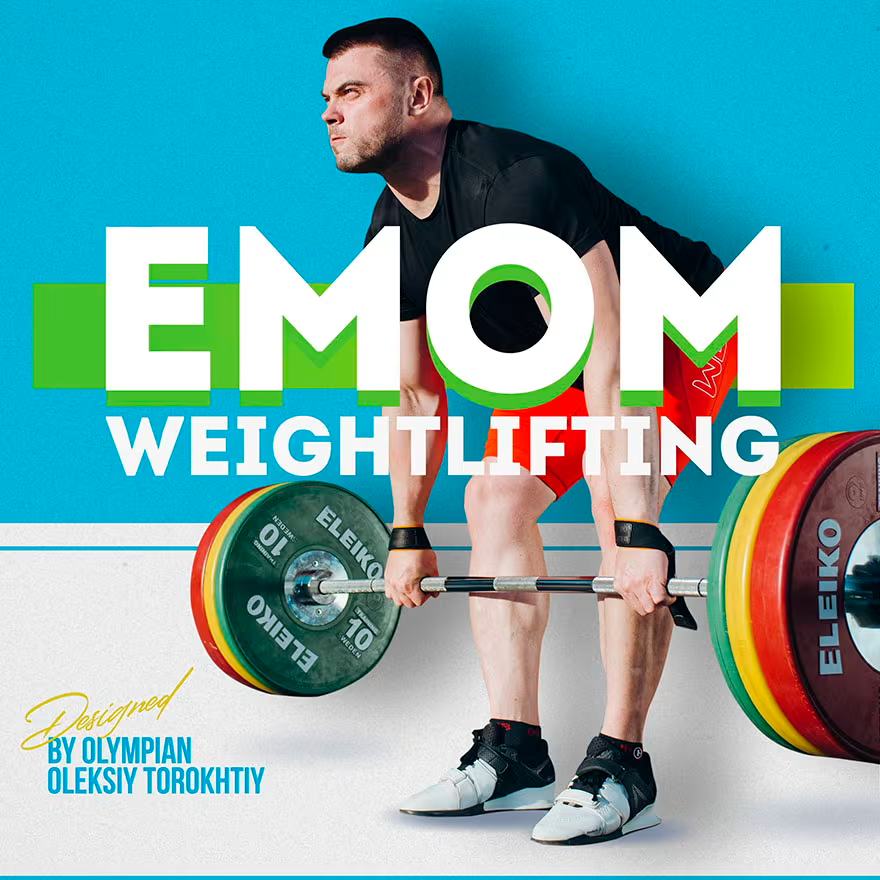
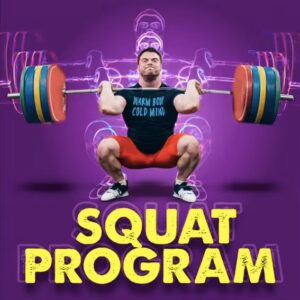
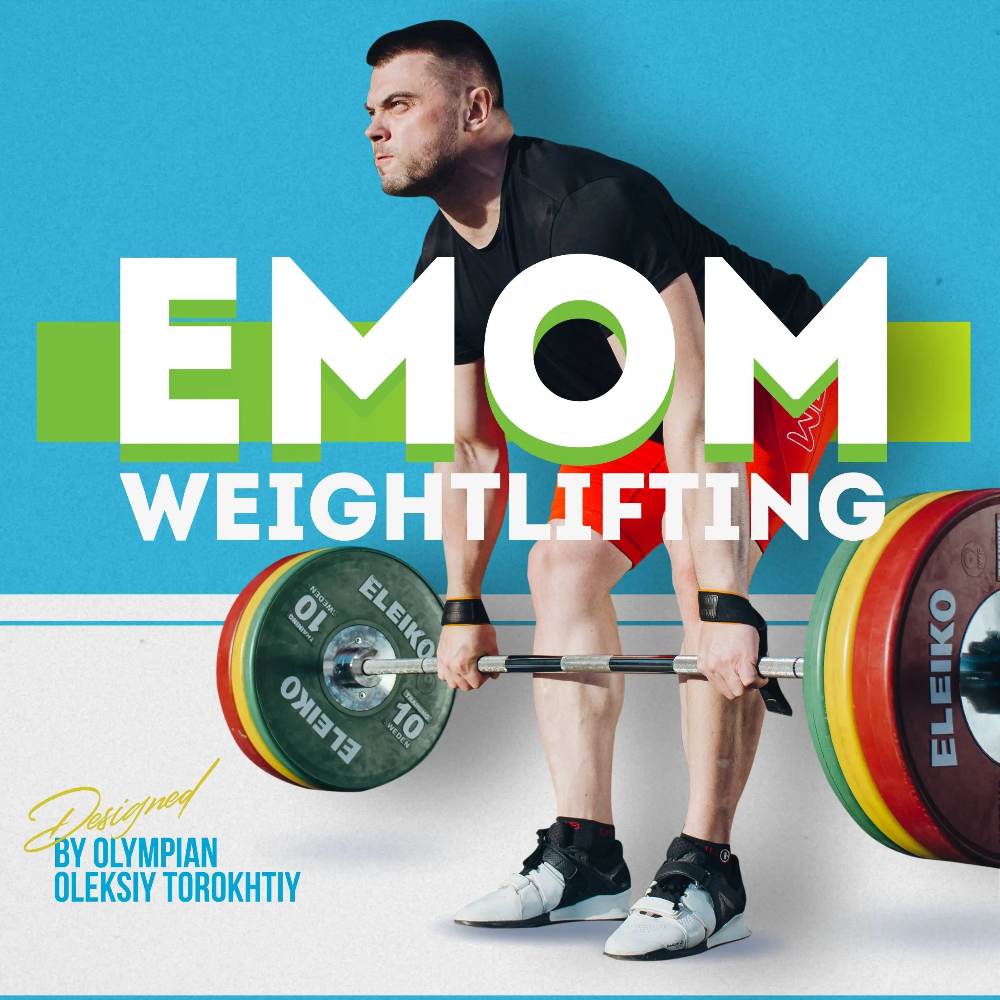
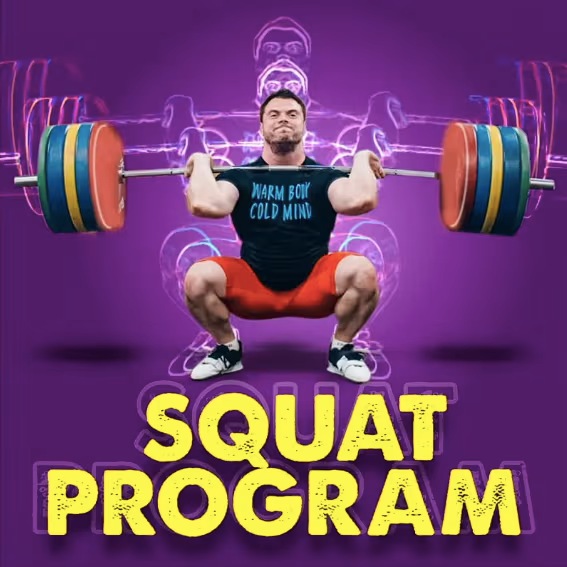

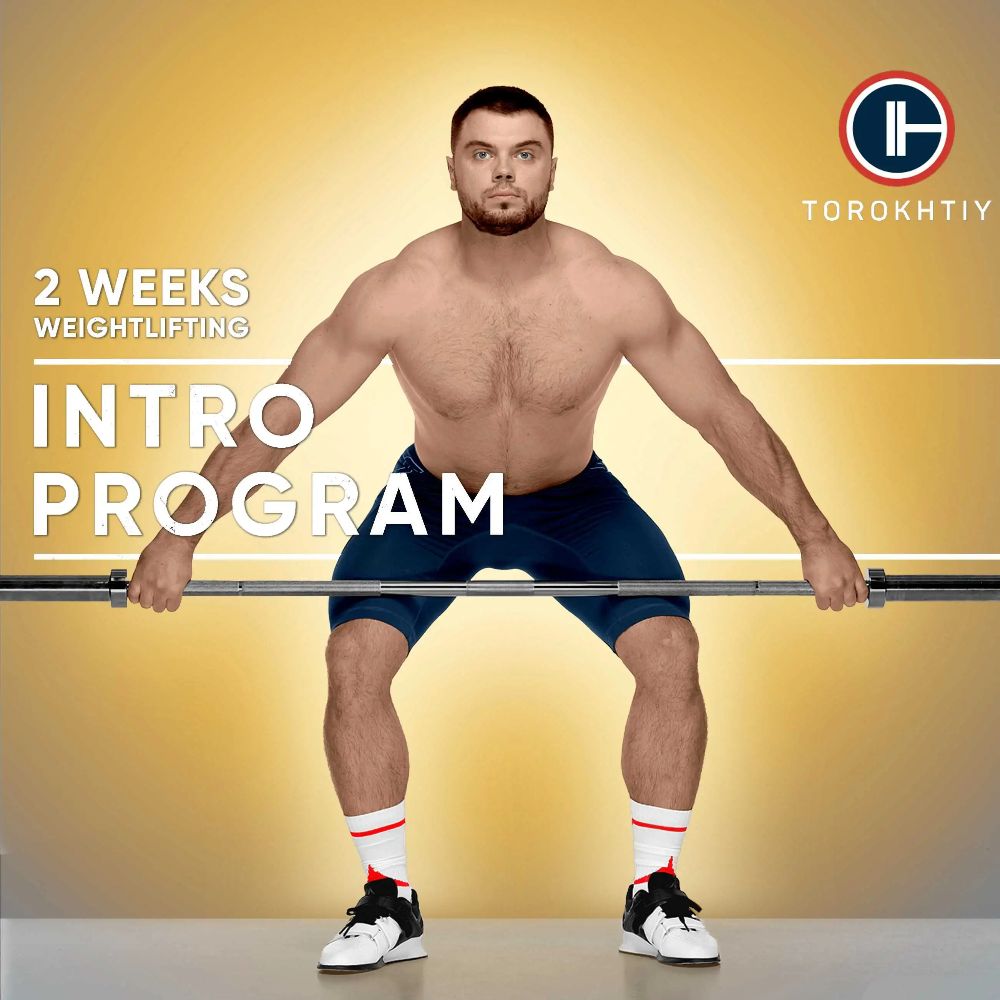
Still have questions after reading our article? Unlock your full potential by engaging with our experts and community! Don’t hesitate — leave a comment below and Oleksiy Torokhtiy will provide a personalized answer and insights to help you reach your goals.